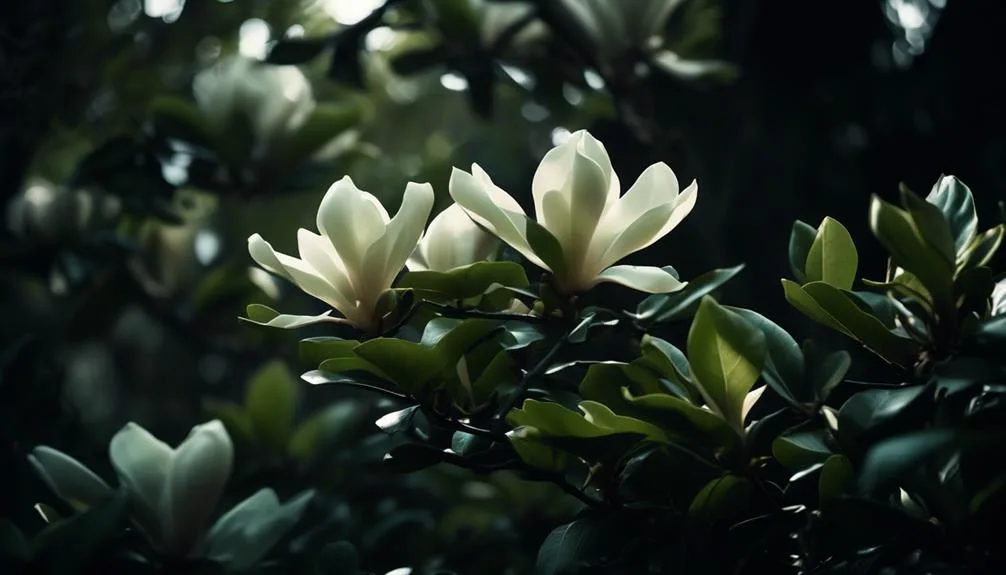Are Magnolia Trees Suitable for Shady Areas?
Magnolia trees come in over 200 species, each with unique traits and growing needs. While they typically thrive in sunlight, some varieties can actually do well in shady conditions. This raises the question: how do these trees cope in the shade, and what factors contribute to their success?
Let's delve into the world of magnolia trees and their ability to adapt to shaded environments.
Suitable Shady Conditions for Magnolia Trees
In order to thrive, magnolia trees require:
- Dappled shade that provides protection from harsh afternoon sun while still allowing some filtered light to reach their delicate leaves.
- Well-draining, slightly acidic soil that is consistently moist but not waterlogged, as excessive moisture can lead to root rot.
- Proper tree spacing to allow for their mature size, which can vary depending on the species. This spacing not only provides ample room for the trees to develop but also ensures that they don't compete for resources.
Ideal Light Requirements for Magnolia Trees
Consider the ideal light requirements for magnolia trees to ensure their healthy growth and vibrant blooms.
- Full Sun: Magnolia trees thrive in full sunlight, receiving at least 6 to 8 hours of direct sunlight daily.
- Partial Shade: While magnolias prefer full sun, they can tolerate some shade, especially during the hottest part of the day. However, prolonged shade can lead to reduced flowering and overall growth.
- Avoid Deep Shade: Magnolia trees should be planted in areas with minimal competition from large trees or buildings that can cast deep shade. Deep shade can hinder their growth and limit their ability to produce flowers.
Understanding the ideal light conditions for magnolia trees is crucial for their overall health and blooming potential. By providing the right amount of sunlight, you can ensure that your magnolia tree thrives and graces your garden with its stunning beauty.
Magnolia Tree Adaptability to Shaded Areas
Adapting magnolia trees to shaded areas requires careful consideration of their specific needs and a strategic approach to optimizing their growth and blooming potential. When selecting a tree species for shaded areas, it's crucial to choose varieties known for their tolerance to low light conditions. Magnolia species like the Star Magnolia (Magnolia stellata) and the Sweetbay Magnolia (Magnolia virginiana) are excellent choices for shaded environments. Additionally, soil quality plays a vital role in the adaptability of magnolia trees to shaded areas. They thrive in well-draining, slightly acidic soil with organic matter. Here's a helpful table summarizing the adaptability of different magnolia species to shaded areas:
| Magnolia Species | Adaptability to Shaded Areas |
|---|---|
| Star Magnolia | High |
| Sweetbay Magnolia | Moderate |
Best Practices for Growing Magnolia Trees in Shade
When growing magnolia trees in shaded areas, it's essential to implement specific practices that cater to their adaptability and promote healthy growth. Here are three best practices for growing magnolia trees in shade:
- Soil Composition: Ensure the soil is well-draining and rich in organic matter. Magnolia trees thrive in slightly acidic soil with a pH range of 5.0-6.5. Amending the soil with compost or peat moss can improve its texture and nutrient content, which is crucial for the tree's overall health in shaded environments.
- Watering Frequency: Although magnolia trees prefer moist soil, they're susceptible to root rot in overly wet conditions. Water deeply but infrequently, allowing the soil to partially dry out between waterings. This helps prevent waterlogged conditions and encourages the development of a robust root system.
- Mulching: Apply a 2-3 inch layer of mulch around the base of the tree, extending it to the drip line. Mulch helps conserve soil moisture, regulates soil temperature, and minimizes weed competition, promoting optimal growth despite the shade.
Considerations for Shady Areas and Magnolia Trees
In shaded areas, magnolia trees require careful attention to their environmental needs in order to thrive and flourish.
When considering the soil moisture for magnolia trees in shady areas, it's important to ensure that the soil is well-draining to prevent waterlogging, which can lead to root rot. Additionally, regular monitoring of soil moisture levels is essential to maintain optimal growing conditions.
Tree spacing is another crucial consideration for magnolia trees in shady areas. Proper spacing allows for adequate airflow and sunlight penetration, promoting healthy growth and reducing the risk of disease. When planting magnolia trees in shaded areas, ensure they're spaced according to their mature size to prevent overcrowding and competition for resources.
Conclusion
In summary, while magnolia trees thrive in full sun, they can also flourish in partially shaded areas given the right conditions. Providing suitable soil, moisture, and sun protection is key to their success in shady spots.
Consider the specific magnolia variety and follow best planting and care practices to support healthy growth in less sunny environments. This highlights the adaptability of magnolia trees and the importance of tailored care for optimal development, encouraging thoughtful consideration when cultivating them in shaded areas.

My interest in trees started when I first saw the giant sequoias in Yosemite.
I was a teenager then, and I remember thinking, “I need to learn more about this.”
That moment stuck with me.
A few years later, I went on to study forestry at Michigan Tech.
Since graduating, I’ve worked in a mix of hands-on tree care and community education.
I’ve spent over ten years helping people understand how to plant, maintain, and protect the trees in their neighborhoods.
I don’t see trees as just part of the landscape.
They are living things that make a real difference in our daily lives.
